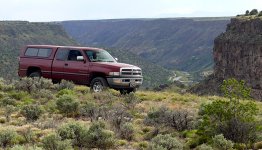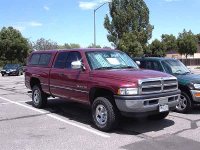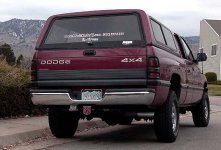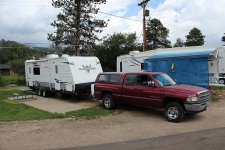Jim.Allison
Well-known member
Jim, are you towing the BC with a 2500 Ram. I know there is plenty of power but does it pull alright. Do you have any concerns. when I pull the trigger on my new Ram diesel, it will be used as my everyday truck when not hauling a rig. sure hate to drive around in a dually. I guess I could get used to one since it's the same width as the trailer. Again, please let me know how it pulls. Thanks in advance.
My 2500 runs like a scalded dog pulling my BC3650RL. Your 3500 SWR will also. Do the math yourself. No salesperson knows anything, at the RV lot or the truck lot.
But your question has to do with handling. The exhaust brake is the best, it is fully functional and changes everything, you want that.
Along with the 3500 you will want the 20 inch wheels with the Firestone HT/AT tires. They have incredible load ratings.
As far as wind is concerned, I have driven in some high winds. The truck handles just fine when the wind is not gusting, the trailer leans though. If your trailer is leaning way over you need to park it. Dually or no dually, If the wind is gusting there are surprises hidden in those gust. Your fiver is huge and that is where the energy is coming from that puts pressure on your truck, both trucks have to compensate for it. In either truck your have your pin load to provide rear stability, in either truck you have the same weight more or less on the steering gear, the only thing that the dually offers is a wider stance in the back and 2x the tire patch. I never noticed the back of my truck being influenced by the wind but the steering gear has to offset the wind hitting the trailer in either truck so I don't see much there is to gain. The upshot is that if your trailer is getting pounded like that then you need to pull into a walmart or a rest area, pop some popcorn and catch up on the news. If a 3500 SWR is getting knocked around that much then a dually probably should not be pulling either. Question; would you rely on the difference between a DRW and SWR to operate in a wind condition that might turn over your fiver? I would not!
I could just say "no problem, buy it!" I won't do that. I will tell you that I ran into severe gusty winds in the Texas Panhandle that I had to manage. The wind blew for about 4 hours before I was able to move out of the low pressure area that was moving across the state (information displayed on the EVIC weather radar, gotta love it). The wind was severe and the gust were worse. The wind gust presented the largest difficulty in that there are little surprises in them. I drove along with SWRs and DRWs and all of us had slowed down because of it, some drove faster than others and some slower, but none were pulling at 65 mph, it was white knuckles. I had the wife on guste watch and dustdevil watch. The reality is; that if it was much worse, I would have pulled over. So the upshot is that I encountered wind conditions and I was able to manage them and I feel that there is little difference between SRW and DRW in that both should not be pulling at 65 mph in the winds that I have encountered. Following these rigs, I could see them leaning, I knew mine was leaning just as bad. DRW and SWR made no difference. Infact I could see a trailer get knocked around ahead of me, from that I knew to slow and expect a hit. We were all in it together DRW SRW, we should of all had our head examined for pulling in it. BTW, I did not see one receiver hitch type travel trailer that day. Normal wind has never presented a problem for my 2500, it rides like a Cadillac.
Question of the day; would you buy a DRW, pay for its operation and maintenance, and put up with all the ancillary problems with driving one and parking one, so that you can handle the off chance that you run into a wind condition that exceeds the capability of a SRW but not a DRW? That is a narrow contingency, if it exist at all.
Hope this helps.
Last edited:




